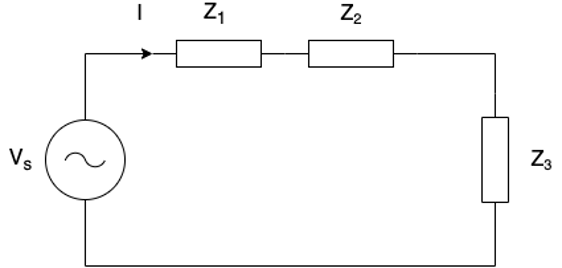5.16.7. Appendix 5.7: Detailed Derivation of EQ EM Pump
The equivalent circuits for the detailed and the simple EM pump models can be reduced to the circuit shown in Figure 5.16.2, where Zi is the impedance of each component in the path of the total phase current, I, being driven by the phase voltage, Vs.

Figure 5.16.2 Reduced Equivalent Circuit for the EM pump models.
Because the equivalent circuits contain inductors, the circuit’s total impedance is a complex number.
Using the total impedance, the total phase current can be quantified using Ohm’s law.
The presence of the inductors introduces a phase difference between the phase voltage and current. The phase difference is defined as
5.16.7.1. Simple Circuit Analysis
For the simple EM pump circuit, the impedance of each component is
Using Eq. (5.16-71) and Eq. (5.16-72), the current as a function of slip, frequency and voltage can be determined.
The current’s dependence on slip is inherent, as Xi=2πLif.
Ohm’s law can be used to determine the division of the total current between the X2 and R2/s branches
Therefore, the power dissipated in R2/s can be defined as
If we assume that a fraction of the power is lost to the fluid, the mechanical power dissipated in R2/s is
Using the relationship between pumping power and pump head, the developed pump head for the simple EM pump model can be described as
5.16.7.2. Detailed Circuit Analysis
For the detailed EM pump circuit, the impedance of each component is
The magnitude of Z3 is
Using a similar analysis as was presented for the simple model, the current passing through the fluid is determined to be
and the mechanical power delivered to the fluid is
Therefore, the developed pump head in the detailed EM pump model is
5.16.7.3. Simple Circuit Parameters
In order to determine the resistance and inductance of the different components in the simple EM pump model, measurable quantities are provided at two distinct pump states. The first pump state, referred to as the rated state, provides a pump head, ΔPR, measured flow rate, QR, measured phase voltage, VR, measured phase current, IR, measured slip, sR, measured efficiency, ηR, and measured frequency, fR. The second pump state, referred to as the stalled state, provides the pump head at stalled conditions, ΔPS, for the measured frequency and measured phase voltage. ΔPP,R and ΔPS,R are functions of the measured pump head, ΔPR, and measured pump head at stalled conditions, ΔPS.
When IDPOPT = 0, then the user-provided ΔPR and ΔPS include pressure changes due to friction losses across the pump. When IDPOPT = 1, then the user-provided ΔPR and ΔPS do not include pressure changes due to friction losses across the pump.
To solve the initial conditions for the simplified pump model, the following terms are defined.
where ΔPf,R is the frictional pressure drop that occurs within the pump at the rated flow rate and IDPOPT is a user-defined flag. ΔPf,R is internally calculated by SAS4A/SASSYS‑1 using the geometry input.
In order to determine the 4 circuit parameters and the current at stalled conditions, five equations are required. Ohm’s law provides us with two of the five equations:
The rated and stall pressures provide an additional two equations:
The final equation comes from the total power dissipated by the pump
Note, the synchronous speed of the EM pump can be determined using the definition of slip and the rated conditions
Instead of solving the five equations at once, an iterative approach is taken. By assuming a stall current, Eq. (5.16-93) can be solved
and plugged into Eq. (5.16-92), providing an equation for R2
with the value of R2 known, X2 can be determined using Eq. (5.16-99) and Eq. (5.16-97) can be solved to determine the value of R1
With R1, R2, and X2 known Eq. (5.16-90) can be used to determine X1
Finally, Eq. (5.16-91) will be solved to determine the error in the stall current. Using error in the stall current, a new stall current will be estimated and Eq. (5.16-99) through Eq. (5.16-102) will be repeated. This process continues until the error in the stall current is within a user defined limit.